Rank Species | Genus Origanum Higher classification Oreganos | |
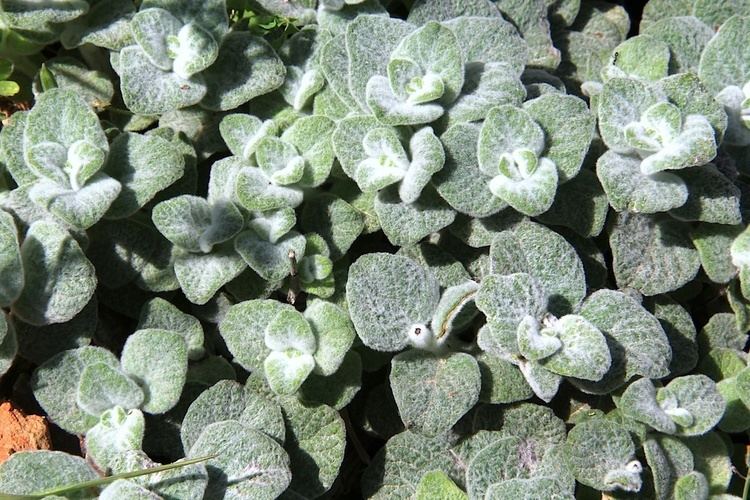 | ||
Similar Oreganos, Sideritis syriaca, Sideritis, Lemon Beebrush, Dictamnus | ||
Origanum dictamnus dittany of crete burning bush
Origanum dictamnus (dittany of Crete, Cretan dittany or hop marjoram), known in Greek as δίκταμο (díktamo, cf. "dittany") or in Cretan dialect έρωντας (erontas, "love"), is a tender perennial plant that grows 20–30 cm high. It is a healing, therapeutic and aromatic plant that only grows wild on the mountainsides and gorges of the Greek island of Crete, Greece. The dittany of Crete is widely used for food flavouring and medicinal purposes, in addition to it featuring as an ornamental plant in gardens. This small, lanate shrub is easily recognised by the distinctive soft, woolly covering of white-grey hair on its stems and round green leaves, giving it a velvety texture. Tiny rose-pink flowers surrounded by brighter purple-pink bracts add an exuberant splash of colour to the plant in summer and autumn. The dittany is classified as vulnerable on the IUCN Red List of Threatened Plant Species 1997.
Contents
- Origanum dictamnus dittany of crete burning bush
- Description
- History
- Fiction
- Aroma profile
- Toxicology
- References
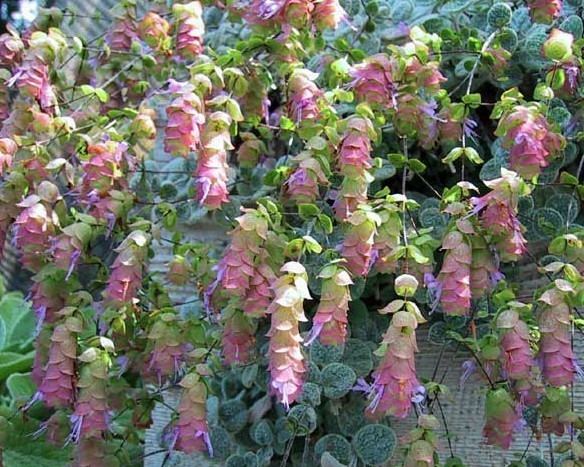
Description

Origanum dictamnus is a many branched plant with discoid to ovate, grey-green leaves that are sited in pairs opposite each other. The slender arching stems and lanate leaves are covered in a velvety white down and are 13–25 mm in size.
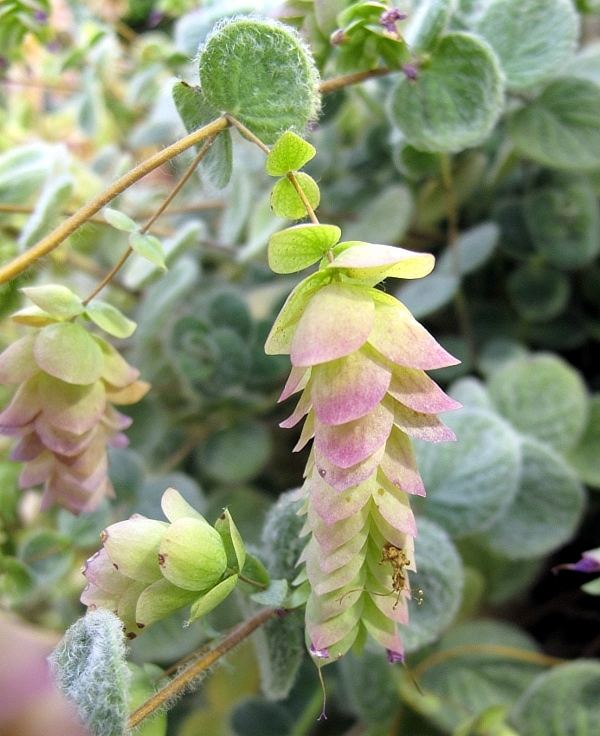
The flowers are pale pink to purple and have a deep lilac corolla with many deep pink coloured overlapping bracts. The colourful flowers forming a cascade of elongated clusters are in bloom in the summer months. The flowers are hermaphrodite, meaning they have both male and female organs, and are pollinated by bees attracted to their scent and bright colour.
The primary ingredients of its essential oil were found to be carvacrol (68.96%), β-phellandrene (18.34%) and p-cymene (4.68%).
History
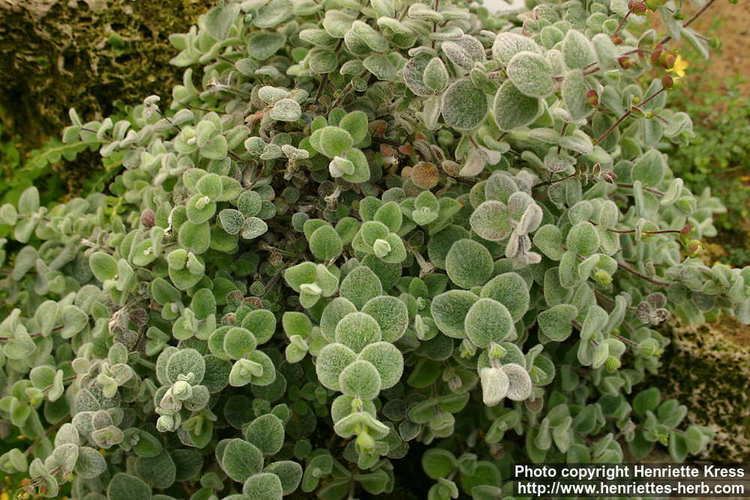
Said to symbolize love and to be an aphrodisiac, only the most ardent young lovers scrambled on mountainsides and the deep gorges of Crete gathering bunches of the pink blooms to present as love tokens. There are numerous deaths reported throughout the centuries by collectors of this magical herb.
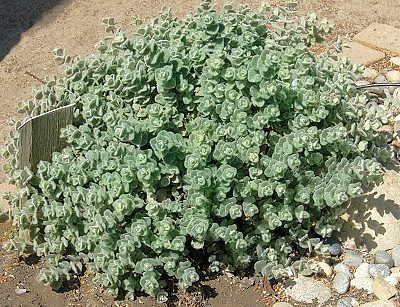
Even in recent times, the collection of dittany of Crete was a very dangerous occupation for the men who risked life and limb to climb precarious rock faces where the plant grows wild in the mountains of Crete. They were named erondades (love seekers) and were considered very passionate men to go to such dangerous lengths to collect the herb.
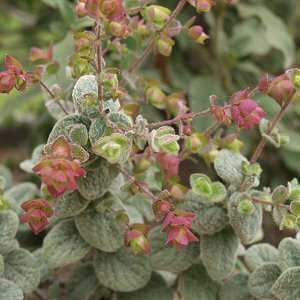
Dittany of Crete has always been highly prized; it is gathered while in bloom in the summer months, and is exported for use in pharmaceuticals, perfumery and to flavour drinks such as vermouth and absinthe.
In Ancient Greece, Hippocrates prescribed plant cures to aid all manner of ailments, and considered dittany of Crete useful for stomach aches and complaints of the digestive system and as a poultice for healing wounds, as well as inducing menstruation.
The Greek philosopher Aristotle in his work The History of Animals (612a4) wrote: "Wild goats in Crete are said, when wounded by arrow, to go in search of dittany, which is supposed to have the property of ejecting arrows in the body."
The Greek scholar and philosopher Theophrastus agreed with Aristotle about the healing properties of dittany of Crete. In his work Enquiry into Plants, he noted that dittany was peculiar to Crete, and that it was: "Said to be true, that, if goats eat it when they have been shot, it rids them of the arrow" (9.16.1).
Other scholars of Ancient Greece and later have made reference to dittany, but probably referred to Dictamnus albus, known as false or white dittany.
Today, the wild, naturally grown dittany of Crete is classed as "rare" and is protected by European law so it does not become extinct. The cultivation now centres on Embaros and the surrounding villages, south of Heraklion, Crete, and is used to make herbal tea and for use in natural beauty products.
Fiction
In Book XII.411-415 of Virgil's Aeneid, Venus heals the wounded Aeneas with dittany: “Hereupon Venus, smitten by her son’s cruel pain, with a mother’s care plucks from Cretan Ida a dittany stalk, [dictamnum genetrix Cretaea carpi ab Ida (412)] clothed with downy leaves and purple flowers; not unknown is that herb to wild goats, when winged arrows have lodged in their flanks.” (Loeb translation).
In Canto XI of Tasso's Jerusalem Delivered the crusader leader, Godfrey, is healed by a dittany salve. This scene is a reference to Virgil's as the dittany used to heal Godfrey is fetched from Mount Ida and reference is also made to the idea that goats eat dittany when wounded.
Charles Baudelaire, in the poem, Tout entière, the 43rd poem in his collection, Les Fleurs du Mal, describes his lover as consisting entirely of dittany: Elle tout est dictame (line 11), she is entirely dittany, referring to the literary tradition of Virgil and Tasso, except that the wound Baudelaire suffers from is not as literal as those that plague Aeneas or Godfrey.
